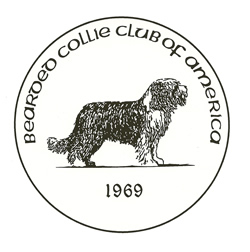(This article appeared in the December 2012 AKC Gazette.)
Several years ago, or maybe more, a Beardie breeder and exhibitor (let’s call him Jeff) went to England and visited several Beardie kennels. At one, a handsome brown Beardie male caught his eye but the breeder wasn’t about to part with the promising pup. However, she promised Jeff if she ever let Wexford go, she’d give Jeff first chance to buy him.
Fate has a way of playing games and some months later, the breeder found it necessary to pare down her crew. She notified Jeff and shortly thereafter, Wexford headed across the Atlantic to his new home. Jeff was pleased with his new dog…..except for one small thing. Make that four small things. Wexford’s paws were stained a tannish color instead of the pearly white paws usually found on Beardies.
Wexford endured a thorough bath but the shampoo failed to lighten the paws, so Jeff turned to whitening shampoo. That too failed to remove the stains. Consulting with owners of white coated breeds, he tried a few other whitening shampoos they suggested. No luck. Conferring with a hairdresser, he attacked the paws with the preparation used to remove every trace of yellow from the silvery locks of senior citizens. The results were somewhat better but still not truly white. In desperation, Jeff bought creme bleach along with some other secret ingredients to intensify the action and at long last, Wexford’s feet were snowy white!
In time, Wexford’s breeder made a visit to North America and went to see Jeff and Wexford. She wrinkled her brows as Jeff explained what he had to do to get Wexford’s feet white again and then exclaimed, “But Jeff, Wexford never had white feet!” Jeff looked surprised for a moment and then shrugged. “He does now,” he declared.
While we’d all like to believe our dogs are naturally beautiful and could walk into a show ring with nothing more than a quick brush-up, it only takes a trek through the grooming area to realize how many aids are employed. Now here’s the big question. Which ones are legal and which ones constitute pure fakery? Looking at the above scenario, let’s suppose Wexford’s paws really were originally white. We know Beardie paws can become stained for any number of reasons. So, at what point did Jeff’s efforts progress from grooming to faking? You might reason since Jeff was only trying to restore the paws to the original color, it wasn’t faking. Or was it?
What about black dogs whose coats have become sunburned to a reddish brown? Isn’t black dye just restoring the coat to it’s original color? Or is it faking?
Walk through the booths at a dog show and see how many coat products are offered. Is there any difference between the color-highlighting shampoos and the color-enhancing sprays? Is there a difference between chalk and corn starch? Is a rinse acceptable but dye forbidden? Where do you draw the line? Where does grooming change to falsifying?
A judge once told the tale of judging best in show at an outdoor event when a rain shower struck. That’s when the coat color of the dog who had gone Best in Show at the previous day’s show began to drip off, leaving the coat on the back several shades lighter than the rest of it. And the exhibitor’s face several shades redder.
Here’s another true story where only the names have been changed to protect the guilty. A young lady we’ll call Jean had two Beardies entered in a show. The younger female was in the midst of a coat change with the front half black and the rear mostly grey. Jean despaired that it made the dog look like two different Beardies joined in the middle. She began to wonder if a little black dye combed discreetly across the back might make the dog look more ‘together.’ So, working in her grooming area the night before the show, she carefully blended the black in over the grey. Pleased with the natural looking results, she tucked the dog away for the night and loaded her into her van the next day in the pre-dawn hours along with her other entry. At the show, Jean groomed the artistically tinted Beardie first in the shade of a tent set up across the rear of her van. She was about to brush up the other dog when a friend came by and told her they were getting ready to start “I’ll take this one to ringside while you finish up that one,” the friend said and taking the lead, off she went. It was then that Jean saw her creation in full sunlight for the first time. The dye job that had looked so natural in artificial light and in the shade took on a different hue in the bright light of day. The rear end of the dog was a brilliant, gleaming purple where the dye had been administered. Snapping a lead on her other dog, she chased after her friend. “Gimme that one, take this one” she wheezed, switching dogs and heading back to the van with her purple pooch. “She’s limping,” she said by way of explanation as she told the steward to mark her absent.
An exhibitor once told of darkening her dog’s light brown coat with tea (skip the milk and sugar) and felt it was acceptable because it was a natural product. Does natural make it legal? Somewhere there’s a line between grooming and cheating but perhaps it only exists in an exhibitor’s conscience.
alice bixler, Summerfield, Florida 34401, alicejb@att.net.




